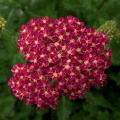Moonshine's
sunny-yellow flower clusters seem to flutter like canaries with wings spread aloft feathery blue-grey foliage. Her
fragrant and finely dissected silvery-sage foliage remains
evergreen and is the perfect backdrop for the bright blossoms (up to 4 inches wide) from June to September.
If you supply good drainage, Moonshine will tolerate
drought and unlike some varieties even tolerates humidity. Though she has a
fast growth rate, Moonshine is
clump forming and does not
spread indefinitely like other Achilleas.
Gardeners often choose Moonshine because she is
shorter and more compact than other Achilleas.
Interesting Fact Moonshine received the Royal Horticultural Society's Award of Garden Merit in 1993.
Gardener Tips Its
basal leaves, but not its upper stems, are
semi-evergreen. Often though, with such stringy leaves, gardeners don't find the look desirable in winter gardens. However, consider employing this trick for a soft, sage evergreen display in winter. When it is time to
deadhead after the last flourish of summer and early autumn blooms, trim the majority of the foliage to a 6-inch height. It returns immediately, but with basal leaves only. Essentially, you achieve a shorter, more compact plant which will have lower flower stems for its final mid-autumn rebloom. Whatever remains of the leaves lasts through winter as a tidy and fern-like clump which is absolutely delightful against a snow-covered garden!
Deadheading
spent flower heads is recommended to promote extended blooming.
For best growth, cut stems back to a couple of inches above the soil after the first killing frost.
Apply a thin layer of compost each spring for more vivid color, followed by a 2-inch layer of mulch to retain moisture and control weeds.
Water plants during the summer if rainfall is less than one inch per week.
Requires good drainage.
Divide plants every 3 to 4 years as new growth begins in the spring, lifting plants and dividing them into clumps. Yarrow is easily dividable by simply digging up a large quantity and shaking loose into clumps. Ideally, this is done in springtime though yarrow will tolerate propagation virtually anytime.
General information that applies to all plants:
-
Ground
preparation, fertilization, pH
-
Planting
instructions
-
Explanation
and description of bare roots
-
How
to plant bare root plants
-
If you
cannot plant bare roots right away
 (0)
(0) Full sun
Full sun







